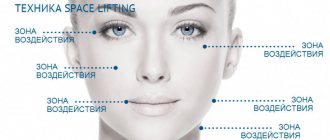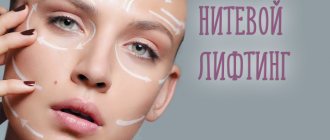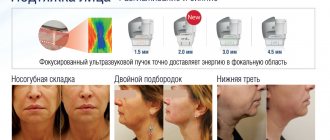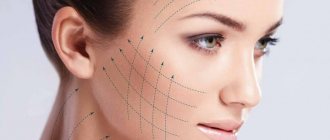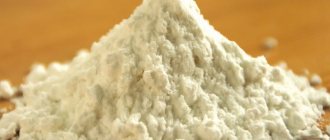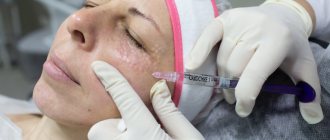Facelift prices
The price for installing endotins is different in each clinic.
First, the number of mini-plates to be used is taken into account, then the place of their insertion, the size of the area on the face that will be corrected, and other factors. The average price of the clamps themselves is in the range of 300-500 dollars for two units, depending on the size and type of plates
But if you take into account the effect, which is superior in quality and duration to other rejuvenation methods. Take into account the wide possibilities and all the advantages of this method of rejuvenation
Then this price can be considered worthy.
Endotins are artificial fixatives that are implanted under the skin to rejuvenate sagging facial structure. This method of surgical lifting (there is also effective space lifting) gives excellent results. The effect obtained from endoscopy lasts for several years. Use this method and let age-related changes pass you by.
About the author: Larisa Vladimirovna Lukina
Dermatovenerology (Internship in the specialty of dermatovenerology (2003-2004), Certificate of the Department of Dermatovenerology of St. Petersburg State Medical University named after academician I.P. Pavlov dated June 29, 2004); Confirmation of the certificate in the Federal State Institution "SSC Rosmedtekhnologii" (144 hours, 2009) Confirmation of the certificate in the Rost State Medical University of the Ministry of Health of Russia (144 hours, 2014); approved clinical protocols. Read more about me in the Doctors-Authors section.
Who needs this procedure?
This is a real salvation for those who have noticed the following signs of aging:
- Deformation of the oval of the face, sagging skin on the cheeks and chin.
- Too deep nasolabial furrows, the appearance of wrinkles going down from the corners of the lips.
- The layer of fat under the skin of the face and neck has shifted.
- Weakening of muscle tone, appearance of a double/triple chin.
- The appearance of wrinkles on the neck.
In one operation, all emerging skin problems can be solved – this is why facial rhytidectomy is convenient. Sometimes it is done under general anesthesia, but if the surgical intervention is not particularly complicated, the surgeon chooses local anesthesia.
What are endotins
Endotins, developed by American cosmetologists, have been used in the USA and European countries for 15 years. Not so long ago, mini-plates, which allow active tightening of the skin of problem areas of the face, began to be used in Russian cosmetology.
The effectiveness of this technique has been sufficiently proven. Its main essence is that as a result of plastic surgery on the face, special plates (endotins) are inserted into the client’s soft tissues, which are made from biodegradable synthetic material and are capable of reliably fixing bone and muscle tissue, inducing them to fuse. Having fulfilled their function, after a certain time, they are broken down and excreted from the body.
The thickness of such plates is only 2 mm, each of them is equipped with teeth located at a certain angle to the board. They allow the fabric to be pulled evenly. The end of such a clamp is equipped with a protrusion, making it possible to attach it to the skull bone.
Each area is affected by a different type of endotin. They Endotins come in different types:
- Endoscopic forehead lift is performed with Endotine Forehead and Endotine Tripple - triangular clamps with 3-5 teeth;
- Shape eyebrows and lift them higher Endotine Transbleph - the same devices with 3 teeth;
- They will improve the plastic condition of the third of the face located in the middle, tighten the cheeks and give greater expression to the cheekbones Endotine Midface - clamps consisting of two parts: the lower extended one, which has teeth and allows you to hold the tissue necessary for tightening, and the upper, long and thin, which is attached to skull bones under the scalp;
- The double chin and sagging neck will be tightened with Endotine Ribbon - fixing tape devices with teeth along the entire length.
What is rhytidectomy?
In simple terms, the procedure is a complex operation to tighten the skin of the face and neck. During the manipulation process, excess fat layer is removed, sagging muscles and skin in a certain area of the face are tightened.
The procedure is carried out over almost the entire area of the neck, forehead, cheekbones and chin, and therefore it is called a circular lift. With its help, you can forget about age-related skin problems for a long time. The effect after the operation lasts for a long time, and the woman can again enjoy attractiveness and youth.
Plastic surgery requires serious preparation from the patient and strict supervision from the attending physician. Before resorting to manipulation, it is necessary to undergo certain tests, undergo consultation with several specialists and properly prepare the body for a serious intervention.
First, the doctor who will perform the operation must conduct an initial examination and make recommendations. In some cases, it is worth resorting to other types of plastic surgery or even simple cosmetic procedures.
Only a qualified plastic surgeon who has considerable experience in this field can give a complete diagnosis of the condition of the facial skin.
Types and indications
Women will never stop striving to improve their own appearance. But today, more and more often, men are also improving their appearance, especially those whose profession or position requires publicity. And there is nothing wrong with this, because if a person looks beautiful and fit, it means that he takes care of himself, including his health.
Types of rhytidectomy
With age, the skin becomes less and less collagen fibers, which give it elasticity. Therefore, the skin becomes less elastic and the first wrinkles appear. The appearance of wrinkles can be caused by various diseases, changes in hormonal levels, and the influence of external factors (weather, production, bad habits). In order to get rid of wrinkles, patients undergo various types of conservative and surgical treatment. Rhytidectomy is the removal of wrinkles using plastic surgery. Excess skin that forms wrinkles is removed. Typically, rhytidectomy is performed as part of a circumferential skin tightening of the face and neck. Today, this is the most effective method of rejuvenation, the effect of which lasts up to 5–7 years (depending on the individual characteristics of the body). Rhytidectomy can be superficial, deep or combined. With a superficial or subcutaneous rhytidectomy, the skin is peeled off and tightened, removing excess. Deep rhytidectomy or SMAS-lifting (the abbreviation SMAS translates as superficial muscular aponeurotic system) involves the capture of dense tissues lying under the skin (muscles, tendons, sometimes up to the periosteum). At the same time, the oval of the face is tightened. The effect of facial plastic surgery using this technology lasts longer, but the risk of complications increases (there is a greater likelihood of injury to nerves and blood vessels) and the recovery period is prolonged. Combined rhytidectomy is a combination of excision of deep tissues (up to the masseter muscle) and excision of superficial tissues in front of the outer edge of the masseter muscle with protection of the facial nerve. Such complex tissue excision makes it possible to separately restore both the skin and underlying tissues, while providing several directions for their tension. As a result of rhytidectomy, drooping facial tissues, pronounced nasolabial folds can be eliminated, a double chin can be removed, and the shape of the face and neck can be restored.
Indications and contraindications
Rhytidectomy is indicated for age-related changes in the face and neck. At the same time, at the age of up to 40 years, rhytidectomy is performed on certain areas of the face and neck, and at a more mature age, excess skin on the entire face and neck is removed with SMAS lifting. Indications for rhytidectomy are:
- age-related sagging of the cheeks (violation of the correct oval of the face);
- sharp deepening of nasolabial folds;
- double and triple chin;
- age-related changes in neck shape.
Read more about cheek plastic surgery - reduction, enlargement, the effect of sunken cheeks and dimples
Contraindication for rhytidectomy
- any acute diseases and exacerbation of chronic diseases;
- diseases accompanied by decreased blood clotting;
- severe diseases of internal organs with impairment of their function;
- skin diseases at the site of the proposed operation.
Very rarely, complications such as infection, damage to blood vessels and nerves occur with rhytidectomy. All complications are successfully dealt with in a good clinic.
By the way, it is possible to have a facelift without surgery at home
Indications
Surgery is performed if there are the following problems:
- pronounced nasolabial folds ;
- drooping eyelids and corners of the eyes;
- vertical cords;
- shaved;
- lack of clarity of contours ;
- formation of a double chin ;
- sagging skin in the cheeks and neck;
- wrinkles;
- loss of firmness and elasticity of the epidermis.
The operation is also performed if the oval of the face “floats”.
Side effects
Complications after this type of plastic surgery are extremely rare. It is worth considering that each organism has its own individual characteristics. Tissue regeneration and restoration of general health proceed differently for everyone. The most common side effects include the following:
- Swelling of tissues. After surgery, swelling on the face and neck area persists for a long time. If this effect does not go away within 10-14 days, then doctors resort to certain therapy and cosmetic procedures. Special cool compresses and preparations for the lymphatic system help well.
- Painful sensations. The attending physician must prescribe painkillers. Over time, their dosage is reduced and the pain should disappear completely. If the feeling of pain does not disappear, then in this case it is worth contacting the specialist who performed the operation.
- Loss of sensation in certain areas of the face and neck. This is quite possible and depends on the characteristics of the organism. As a rule, the effect wears off within a couple of weeks after surgery.
If the procedure is performed competently and efficiently, the patient will go through the rehabilitation period quickly and painlessly, and the result will leave the best impression for a long time.
Complications
The cause of unforeseen consequences may be the surgeon’s violation of the technique of performing the intervention or the patient’s failure to comply with the rules before and after surgical care.
On this topic
- Lifting
Fractional RF lifting
- Olga Aleksandrovna Kalinina
- September 17, 2020
Among the most common complications are:
- damage to the facial nerve and, as a result, improper functioning of facial expressions;
- asymmetry ;
- scarring due to improper suturing - if it persists for a long time, it is removed through surgery;
- formation of ulcers ;
- infection of the wound surface;
- keloid scars;
- hyperpigmentation;
- damage to blood vessels.
Hair may also begin to fall out, which occurs as a result of thinning and weakening of the hair. Alopecia can occur not only in places where sutures are applied, but also in other areas. To choose the right therapy, you will need to accurately determine the cause that provoked such a complication. If stress is a provoking factor, drug treatment is prescribed. If the problem is scars, they are removed surgically.
Details of rhytidectomy
Typically, rhytidectomy is performed using general anesthesia and lasts 1.5 – 2.5 hours. The incisions are placed so as to camouflage the scars as much as possible - in the folds of skin in front or behind the ears; if necessary, the surgeon can extend them, moving them under the hairline. Typically, a facelift is performed at the same time as a neck lift by making another incision under the chin. After this, the skin and muscles are peeled away from the underlying facies, and excess skin tissue is excised.
At this stage, if necessary, liposuction is performed - removal of fatty tissue from the cheeks, chin, and front of the neck. The last stage of the operation is to tighten the skin, then the incisions are stitched.
Most often, rhytidectomy takes place on an outpatient basis, but sometimes the patient is recommended to stay overnight under the supervision of doctors.
Progress
A surgical facelift is performed in several successive stages.
First, the skin is cleansed and in-depth or general anesthesia is administered. After the anesthetic substance takes effect, the surgeon proceeds directly to solving the problem.
Using a scalpel, the skin is incised in the temple area. The incision will pass in front of the ear, going around the lobe and ending behind it in the area of the scalp. When it is necessary to remove the double chin, an additional small incision is made from the inner edge of the lower jaw.
Such actions are necessary for subsequent unhindered detachment, and its area will increase depending on the degree of weakening of the soft tissues. Next, the specialist dosed and precisely stretches the muscular aponeurotic surface. This is necessary to correct deep sagging.
For local fat deposits, the surgeon performs lipectomy or liposuction involving the cervical region, jaw area, chin and cheeks. If the volume is not enough, then the space is filled with adipose tissue.
Next, the specialist excises excess skin, aligns the edges and applies a surgical suture. At the final stage, a special retaining bandage is fixed on the head.
The duration of the entire surgical process takes 1.5-4 hours.
Postoperative period
To avoid complications such as hematomas, infection, etc. The patient has been in our clinic for about 7 days. She is given dressings daily, and her general condition and well-being are carefully monitored.
For another week after discharge, the patient independently takes care of the stitches and performs the necessary hygiene. It is recommended to wear a compression bandage on your face for two weeks, which reduces swelling and provides some comfort.
“Active” rehabilitation lasts about three weeks. Then you can return to normal operating mode. If you are expected to undergo strenuous physical labor, your surgeon will provide additional recommendations for recovery.
What is rhytidectomy?
This is a circular tightening of the skin of the face and neck, performed on a surgical table. What a rhytidectomy is, the doctor will explain best and in more detail when he recommends ways to restore the lost shape of the oval of the face. He will also choose the most optimal option for plastic surgery.
Important! Facelift, SMAS-lifting, MASC-lifting - these are all types of rhytidectomy. What exactly the surgeon will choose and recommend depends on the general condition of the skin and the problems that need to be solved.
The postoperative period is not particularly long. The sutures are gradually removed (and the internal ones dissolve on their own), swelling and hematomas are removed. The skin is tightened, freshened, and thanks to the bandage, the oval of the face becomes clear. The surgical intervention lasts 2-4 hours, the rehabilitation period is about 2 weeks, it is individual for everyone. The results of rhytidectomy last for 6-10 years. If you lead a healthy lifestyle and take care of your skin, you can extend your youth.
How is a face and neck lift performed?
This operation is not considered particularly difficult. Until the age of 40, it is done only in certain areas, and after that - the full version. The plastic surgeon makes incisions in specific locations (along the hairline, in front and behind the ears, under the chin), then stretches the loose skin and secures it in position. Excess skin is excised and removed. In some variants of rhytidectomy, surgical instruments reach the muscles, tighten even the deep layer and thus form the ideal oval of the face. After the stitches are applied, everything is secured with a bandage and the patient is sent to the ward on a gurney. Recovery from anesthesia occurs almost immediately.
Find out more about facelift:
End result and possible complications
If the operation is done efficiently, the rehabilitation period is easy. The bandage is removed on days 4-5, the stitches a little later. Swelling may appear, but it goes away within 1-2 weeks without a trace. Sometimes patients note that skin sensitivity has disappeared in some areas of the face, but this is also a temporary phenomenon. It happens that the scalp suffers - hair begins to fall out where the incisions were. But as a rule, the hair is quickly restored. Complications after rhytidectomy include the appearance of pigmentation.
The first results are noticeable within a couple of months. The face becomes young and attractive. And the full effect will be noticeable in about 6-7 months and will last 6-10 years. Clear cheekbones, restored oval face, complete absence of jowls and sagging cheeks, as well as wrinkles. But to get excellent results, you must follow all the advice of the plastic surgeon.
Recommendations for plastic surgery
With age, the appearance of a woman, and a man, also undergoes certain changes. All this is associated with inevitable age-related processes in the human body.
Rhytidectomy is performed in the following cases:
- The contours and clear outlines of the neck are disturbed. The skin sags. She looks fading
- Deep nasolabial folds.
- Permanent wrinkles on the forehead and bridge of the nose.
- Drooping eyelids and deep folds in the eye area.
- Sagging cheeks.
- Neck folds and double chin.
All these are signs of skin withering and aging. Due to the loss of certain substances in the skin and muscle tissue, irreversible processes occur that can only be changed through surgical intervention.
The epidermis of the face needs additional nutrition and hydration. Conventional creams are not able to fill this deficiency, and mesotherapy gives a short-term effect. In this case, rhytidectomy would be the most appropriate way to combat aging. It returns deformed tissues to their place and gives them the required shape. Moreover, the entire internal structure has the necessary fixation, which ensures a long-lasting effect.
Speaking about indications, there is no way to avoid contraindications to the procedure:
- The manipulation is impossible if you have skin diseases of the face and neck.
- Lifting is contraindicated in case of blood diseases, in particular those with poor plasma coagulability.
- Acute diseases of internal organs.
- Diseases of the cardiovascular system.
- Oncological diseases.
- Too young. A facelift is usually performed after 40 years of age. Although young women often turn to such extreme methods to improve their appearance.
In fact, if the human body is able to synthesize the necessary substances for the normal condition of the skin, it is worth resorting to less drastic ways to change your appearance. For this purpose, there are various cosmetic procedures and products that can cope with minor skin defects.
Any intervention in the human body requires a preliminary full medical examination. The presence of various diseases and disorders of the internal organs is a serious reason for refusing surgical intervention.
Contraindications
You cannot do a circular lift if:
- cancer;
- clotting disorders ;
- infections;
- decreased elasticity ;
- diseases of the heart and blood vessels, occurring in acute form;
- diagnosed diabetes mellitus ;
- breastfeeding . _
On this topic
- Lifting
Vector lifting
- Olga Aleksandrovna Kalinina
- October 21, 2020
In addition, the procedure is contraindicated during pregnancy.
If the patient has a predisposition to the formation of keloid scars, then this type of surgical intervention will also have to be abandoned.
Recovery period and results
The rehabilitation period after face lifting lasts 1.5-2 months. The patient spends the first 2-3 days after surgery in the hospital under constant medical supervision. During this time, he suffers from severe swelling of post-operative wounds (it causes psycho-emotional discomfort and interferes with talking), painful sensations and a slight increase in body temperature. To relieve pain, doctors prescribe oral painkillers, and to prevent the development of infection, they prescribe broad-spectrum antibiotics to their patients.
The first dressing is done 5-6 days after the procedure. Removal of the suture material occurs gradually: during the first dressing, the sutures located in front of the ear and under the chin are removed, and on the 9-10th day the sutures in the behind-the-ear area are removed. Immediately after their removal, a strip strip is applied to the wound, which promotes the formation of an even and smooth scar. By the end of the first week after the procedure, the swelling becomes barely noticeable, but it will finally disappear in 2-3 weeks.
After removing the suture material, you are allowed to wash your hair; until this point, water should not come into contact with the skin sutures. It will be possible to dye your hair only after a month.
Doctors allow the use of decorative cosmetics for 8-10 days. You can visit the sauna, swimming pool, have a massage or engage in heavy physical labor no earlier than after 2 months.
The preliminary result after a facelift of the face and neck is assessed after 5-6 weeks, and the final result – after 6-12 months (after complete restoration of the skin and the end of the period of scarring of soft tissues). It depends on the patient’s age and lifestyle, the presence of bad habits and compliance with the doctor’s postoperative recommendations. The rejuvenating effect of the procedure lasts for 7-9 years, after which the operation is repeated.
An additional course of mesotherapy, biorevitalization, and lymphatic drainage massage helps consolidate the result and prevent the reappearance of wrinkles or soft tissue ptosis.
Rehabilitation period
Almost always, recovery after a facelift is accompanied by swelling of the soft tissues - this is the body’s natural reaction to surgery; in addition, small lymphatic vessels are inevitably damaged during the operation.
In order to reduce swelling, a compression bandage is applied immediately after rhytidectomy is completed. It is strictly forbidden to remove it without a doctor’s permission, since excessive swelling of the tissues can cause the sutures to come apart; usually the period of wearing it does not exceed 3-5 days. For severe pain, painkillers are prescribed. As a rule, stitches are removed within 7-10 days. Complete tissue restoration after a facelift takes 1-2 months. For some time after surgery, the skin on your face may become dry and begin to peel; these phenomena are normal and will pass over time. Often, to enhance the rejuvenation effect, a face and neck lift is combined with other techniques, since rhytidectomy eliminates deep wrinkles and folds on the skin, but does not eliminate fine wrinkles, such as “crow’s feet” around the eyes. Typically, rhytidectomy is supplemented with a forehead and eyebrow lift, installation of facial implants, and injections of botulinum toxin.
Rhytidectomy
Rhytidectomy – face and neck lift
ALL ABOUT PLASTIC SURGERY AND COSMETOLOGY – PLASTYSURGERY.RU – 2009
The most noticeable signs that “hint” at a person’s age are wrinkles in the face and neck. The condition of facial skin is affected by solar radiation and constant stress, from which, unfortunately, no one is immune. Typical problems with which patients turn to plastic surgeons are deep wrinkles between the nose and the corner of the mouth (nasolabial fold), sagging skin in the lower jaw and folds on the neck, excess skin in the chin area, drooping eyebrows, the appearance of “saggy cheeks”, uneven pigmentation. A popular and effective method of eliminating the above problems is a face and neck lift (lifting), the so-called rhytidectomy.
Today, facelift is the optimal and effective method of removing visible signs of aging. The main result of rhytidectomy is rejuvenation of the face and neck. The main indication for lifting is the condition of the skin, not biological age. Typically, patients (both men and women) are between the ages of 40 and 60, but skin lifting can also be performed on younger people who have already shown the above signs of aging. The main condition is good health for those who want to correct their appearance.
Classic method of rhytidectomy
Rhytidectomy is performed under general anesthesia or with the combined use of analgesics and sedatives, the surgeon removes excess skin through incisions in the postauricular area and the scalp area. Typically, the incision follows the natural line of the anterior edge of the auricle and goes further behind the earlobe up to the scalp. If the chin area is being corrected, a small incision can be made under the chin at the same time.
Using special instruments in the subcutaneous tissue, the skin is carefully separated from the underlying tissues, making it mobile. If there are fat deposits in these areas, the operation can be combined with delicate liposuction
Then the skin is tightened, thereby straightening wrinkles. Excess skin is removed, and the surgeon applies cosmetic stitches. The duration of the operation is usually 1.5 - 3 hours, but when combined with other operations it can last longer.
Rhytidectomy can be performed as a stand-alone procedure or in combination with other surgeries, such as blepharoplasty (eyelid surgery). But with extensive surgery, the doctor performs other operations as the next step. On days 7-10, the sutures are removed. Sometimes plastic surgeons place drains under the skin of the face and neck to ensure fluid drainage in the early postoperative period. This facilitates and speeds up the healing process. An elastic bandage also secures the surgical area.
Results of rhytidectomy
The first results are visible to the patient after 2-3 weeks, the final results – after 1.5-2 months. The lifting effect lasts from 5 to 7 years. Over time, due to age-related changes, the effect of rhytidectomy decreases, however, repeated surgery is possible, which will prolong your youth for another 5-7 years
To get a good result, it is important to establish mutual understanding and interaction with the surgeon, therefore, during preliminary consultations, the patient must ask all the questions that concern him and that are unclear to him
A facelift operation will preserve freshness and youth for a long period, but the result should not surprise others with its unnaturalness. Therefore, before you decide to undergo surgery, you must carefully imagine the future result and discuss your expectations with the surgeon.
About the procedure
A facelift (rhytidectomy)
is a plastic surgery to eliminate signs of age-related skin changes. A facelift is one of the most popular plastic surgery procedures, allowing you to smooth out wrinkles and folds, even out skin texture, and restore freshness and youth to your face.
Today, many different techniques are used to combat skin changes caused by aging. However, only rhytidectomy often achieves the desired result when other tested methods have proven ineffective.
Of course, a surgical facelift is one of the most radical methods of skin rejuvenation, but the duration of its effect is measured not in months, but in years.
Experts identify
five criteria for age-related skin changes
:
- wrinkles,
- loss of skin elasticity,
- ptosis (sagging) skin,
- the appearance of pigment spots,
- loss of volume of soft tissues of the face.
Minimally invasive rejuvenation methods are quite capable of restoring tissue volume, eliminating wrinkles and pigmentation, but only rhytidectomy can effectively solve the problem of loss of elasticity of skin tissue and get rid of ptosis. The recommended age for it is 40-50 years
, when signs of aging have already appeared, but the skin has not yet lost its ability to regenerate. Accordingly, the indication for a facelift will be ptosis of the skin tissue, as well as the loss of elasticity and firmness and, of course, the woman’s desire to eliminate these signs of aging skin.
Stages of the operation
Rhytidectomy is performed under general anesthesia. On average, the operation lasts at least 2-2.5 hours. How much time will be spent on the procedure also depends on the total amount of work of the surgeon in each specific case. The cost of rhytidectomy is quite high. On average, the cost of rhytidectomy in Moscow clinics starts from 280,000 thousand rubles.
The entire lifting process can be divided into 3 main stages:
- The surgeon makes marks and determines places for tissue incisions. The patient is then given general anesthesia. In most cases, the line runs from the highest point at the temple to the lowest point of the outer edge of the auricle. In more complex cases, the marking is carried out under the earlobe and goes behind the auricle. If the surgeon is dealing with a chin lift, then the incision line will be in this area of the face.
- At the second stage, the excess part of the skin or fat layer is directly tightened and cut off. In his work, the doctor uses special tools and equipment, which allows him to accurately perform all surgical procedures.
- The final stage is suturing. The tissues are stitched intradermally with special threads, which after these procedures completely dissolve and leave no traces.
After the operation is completed, a special bandage is applied to the face and neck area, which provides reliable fixation and promotes rapid healing.
Video of the rhytidectomy operation (facelift, forehead and neck lift):
Next comes an equally important stage of the procedure - the rehabilitation period. Skin tightening can be considered successful only after completion of rehabilitation. It lasts on average 1-2 weeks.
The patient is required to comply with certain rules and recommendations of the doctor. During the first 10-15 days, you should avoid physical activity, visiting the sauna, swimming pool and sunbathing.
It is very important to maintain a healthy sleep and rest schedule. The use of various types of medications must be agreed with a doctor
The final result can be assessed only after 1-2 months. By this time, the tissues should have healed and the swelling should have gone away from the face. The results can be seen in the photos before and after rhytidectomy:
The effect of the operation lasts for at least 10 years. Repeated tightening is carried out taking into account the previous one. Methods during surgical procedures may be used slightly different.
Preparation
Circular facelift surgery involves preparation. First, the patient comes to a specialist for an examination, during which the doctor assesses the general condition of the skin, determines the range of problems that need to be solved, and gives a referral for a diagnostic examination.
Surgery will be refused if there are no results for the following types of diagnostics:
- blood and urine tests
- biochemistry to determine the concentration of bilirubin, potassium, urea, glucose, total protein, sodium, AST and ALT;
- coagulogram;
- electrocardiogram;
- analysis for Rh factor and blood group, syphilis and HIV;
- fluorography.
You need to pay attention to the period of the menstrual cycle. The operation is not performed at the time of menstruation and 4 days before and after it.
Approximately 14 days before a plastic facelift, you need to stop smoking, drinking alcohol and taking medications that help change the level of blood clotting.
One day before the appointed date, it is forbidden to eat fatty foods. You can eat easily digestible food, but no later than 8 hours before the intervention.
On this topic
- Lifting
Short scar facelift
- Editorial board of Plasticology.ru
- October 21, 2020
On the day of execution, you need to wash your hair and remove any remaining makeup from your face.
All these measures contribute to successful implementation, obtaining the desired result and preventing the development of undesirable consequences.
Features of the recovery period
To get the maximum effect from facial skin tightening and reduce the likelihood of unpleasant consequences, it is important to follow rehabilitation standards. The duration of the postoperative period is usually 1-2 weeks. During the first month, you need to adhere to a special regime, including avoiding heavy physical activity and all types of sports training.
It is worth reviewing your diet, enriching it with fruits, vegetables and foods high in simple proteins and low in sodium.
Clothing should be comfortable and not constrict the neck area, shoes should have flat soles. You will have to forget about taking a hot shower, visiting the bathhouse and sauna for at least 2-3 weeks, and about dyeing your hair for 1 month.
results
A facelift allows you to achieve stable and long-lasting results in several ways: completely eliminate or smooth out deep wrinkles and folds (especially on the neck and cheeks), restore the contour lines of the neck and chin, correct the oval of the face and restore its clarity.
If the operation was performed at the age of 40 to 50 years, then the average duration of preservation of the result is 10 years. If the patient's age is from 50 to 60, then the time efficiency indicator is reduced to 5-7 years.
Clinics performing rhytidectomy are presented on our portal. Here you will find all the necessary information about each of them: addresses, telephone numbers, list of doctors, etc.
